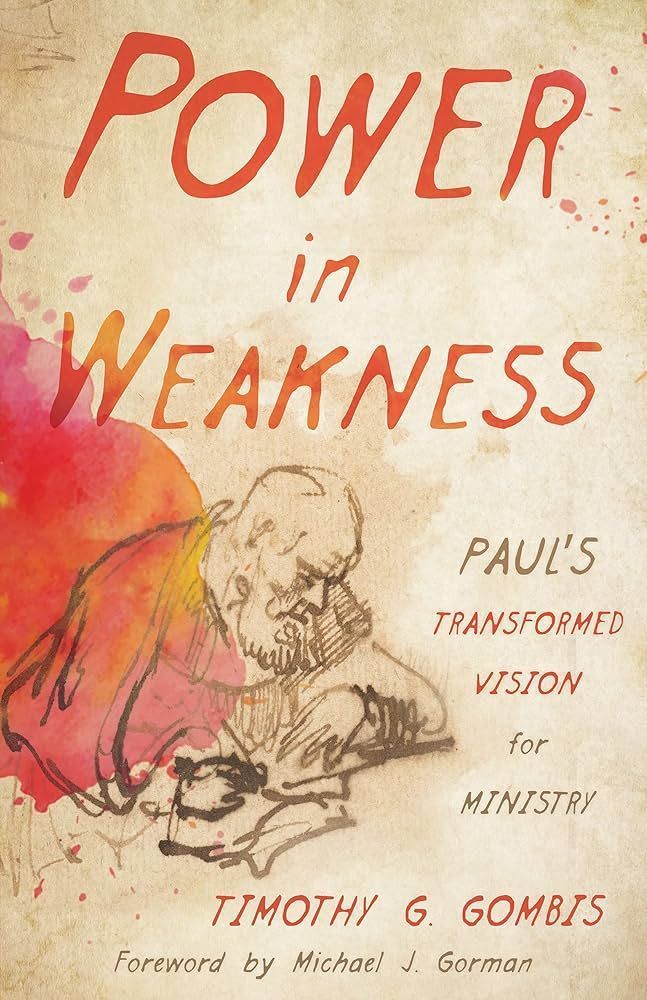Power in Weakness Book Review
Josh Cramer • September 28, 2023
A review of Tim Gombis' look at Paul's pastoral theology

On Tim Gombis’s Power in Weakness: Paul’s Transformed Vision for Ministry (Eerdmans, 2021)
Gombis’ goal is to describe Paul’s journey in ministry and explore how Paul’s conversion and redeemed theological imagination provide a foundation for Kingdom ministry. He looks at Paul’s journey, his theology, and how to apply his theology to pastoral ministry today. It’s part biography, part academic theology, part New Testament scholarship, and part pastoral theology. But it’s also personal, as Gombis takes us through his own story and wrestlings in pastoral ministry (he is a New Testament scholar and pastor). And, in the interest of locating him on the theological map, Gombis is a creative pastor-theologian influenced by NT Wright, Michael Gorman (who wrote the Foreword), Bruce Longenecker, and Marva Dawn, among others. If you know these writers, you’ll rightly anticipate that Gombis won’t advocate for leadership as power, or push us toward the megachurch model.
Instead, Gombis wants to show us how Paul moved from seeking power as a way of working toward the Messianic Age to seeing Jesus’ death as inviting the power of God in the resurrection; and, he is inviting pastors today to follow Paul’s shift from power-seeking to cruciform (that is, cross-shaped) ministry. The first chapter, “Paul’s Unconverted Ministry”, sets the stage by describing Paul’s vision for the Kingdom pre-conversion. Gombis describes Paul’s mission of bringing the resurrection into reality through exercise of power. This led Paul to use coercion, to compete, to identify with power, to protect his image, and to pursue agenda over people.
Chapters 2 and 3 detail the conversion of Paul’s understanding of resurrection and of ministry. Chapter 2, “Conversion of Paul’s Resurrection Imagination”, explores how Paul comes to understand following the cruciform life of Jesus as the way to invite resurrection. Chapter 3, “Conversion of Paul’s Ministry Imagination”, describes what that new understanding of resurrection means for Paul’s ministry and ministry identity. To follow the cruciform life of Jesus in ministry implies a rejection of power and image and instead a pursuit of weakness and an identity as a sinner. Gombis’ discussion of how ministering out of our weakness and shame unleashes God’s resurrection power was one of my favorite early sections of the book. As Paul learns to love and follow Jesus, he wants to identify with him in his shame and suffering, which is terrifying and feels like the only honest way to follow Jesus. When Paul is renewed in the Gospel, God unmakes and remakes his whole vision for life and ministry in Jesus’ image.
Chapter 4, “Pastoral Ministry in Cosmic Perspective”, feels a bit like an appendix to the central argument of the book, though I can imagine that, for Gombis, this is really the beating heart. I can’t finally decide whether I love its place here or wish Gombis had placed it elsewhere (as a first chapter to set the stage for the rest of the book? as an appendix to provide some additional context? as part of a different book on Paul’s cosmology?). In its current location, Gombis wants us to see how Paul’s remade vision for life and ministry plays an important role in the cosmic battle that God is waging against the powers and rulers of this evil age. Ministry as Paul had done it pre-conversion serves the rulers of this age; cruciform ministry in the way of Jesus invites the resurrection power of God and provides hope to an enslaved world. I do love that this chapter elevates the cosmic significance of life and ministry while pointing to the cruciform, resurrection-inviting way of Jesus. Our lives are involved in the heavenly battle, and the way we enter into that battle matters more than we want to believe.
Chapters 5 through 8 explore the practical implications of Paul’s converted imagination for ministry today. In “Cruciform Ministry and Image Maintenance”, Gombis recognizes pastors’ tendency to try to develop and control our images while inviting us to follow Jesus in allowing ourselves to be seen as weak. In “Cruciform Ministry and Credential Accumulation”, he points to our insecure need for credentials and how Paul identifies with a shamefully crucified Lord. In “Cruciformity, Passivity, and Taking the Initiative”, explores some key areas where cruciform ministry might look differently than our current practice: preaching, church discipline, how we deal with “big sins”, and how to face and accept our limits. I found Gombis’ thoughts on our limits especially helpful: our ambitions and false motives have been nailed to the cross and so we are called to minister out of humility. In “Cruciform Ministry Postures”, Gombis helps us to see that the pastor’s role is not to “lead” in the ways we might normally understand that term, but to pay attention to what God—the Leader and Pastor of our churches—is doing.
If I have a complaint with Power in Weakness, it has to do with my own lack of clarity regarding chapter 4. I’m just not sure that the material’s placement in between Gombis’ discussion of Paul’s converted imagination in the second and third chapters and the ministry implications in the second half of the book was helpful to my own reading. It felt like a giant rock fell into the middle of the stream of the argument. To be clear, I value the content and believe it adds weight and depth to my own understanding of the why and how of ministry but I’m unclear about the placement.
That one complaint aside, I find this to be as helpful as anything I’ve read on biblical foundations for ministry. Want to know how to build a healthy and God-honoring ministry? Want to avoid the dangers of modern ministry? Want to minister out of an integrated, Jesus-centered life? Want your ministry to have a Jesus-sized impact (and not a consumerist, image-centered, or CEO-sized one)? I recommend starting here. Gombis has given us a useful guide for those ready to do the hard work of searching ourselves, submitting our hearts to a crucified Lord, and trusting God to raise the weak, dead, and sinful parts of ourselves. In a time and place where we are dealing with crisis after crisis of church mismanagement and leadership failure, Gombis has given us a deep and thoughtful path toward healing and wholeness, following Paul who follows Jesus.

This is how I remember Lent as a kid: go to mass on Ash Wednesday (I have no memory of any sermon, lol), vow to give up something (that lasted as long as a New Year’s resolution), and eat Long John Silver’s fried fish on Fridays (their hushpuppies and crunchies…mmmm). We didn’t eat meat on Fridays (unless we forgot, but we prayed, so it was ok); it was something everyone in the church did, right? I knew it was leading up to Easter--other than that, I had no real understanding or connection to it. Lent was taught more like an obligation rather than an opportunity. An opportunity to reflect, rejoice, rest, repent (what other “r” words can we think of?) on Christ’s journey to the cross. The next 40 days is an opportunity, an invitation to draw closer to the Giver of Life. For some, this might look sacrificial (giving something up), for others it might be a genesis (starting something new), or it can be a combination of the two. “Your kingdom come, Your will be done, On earth, As it is in heaven” Our Lord doesn’t just teach us to pray, he embodies prayer. He inaugurates God’s kingdom on earth through his presence with us; through his faithful obedience, we get to see and experience heaven on earth. This does not come without temptation, and trials, and wandering astray at times—yet our loving God invites. He invites us to remember, to reengage with the One who creates and holds all things; He invites us to lay down our lives and pick up our crosses. We want to invite you to participate with RCB, as we journey with Christ to Calvary, praying for the strength to be obedient… Your kingdom come, Your will be done, On earth, As it is in heaven.









